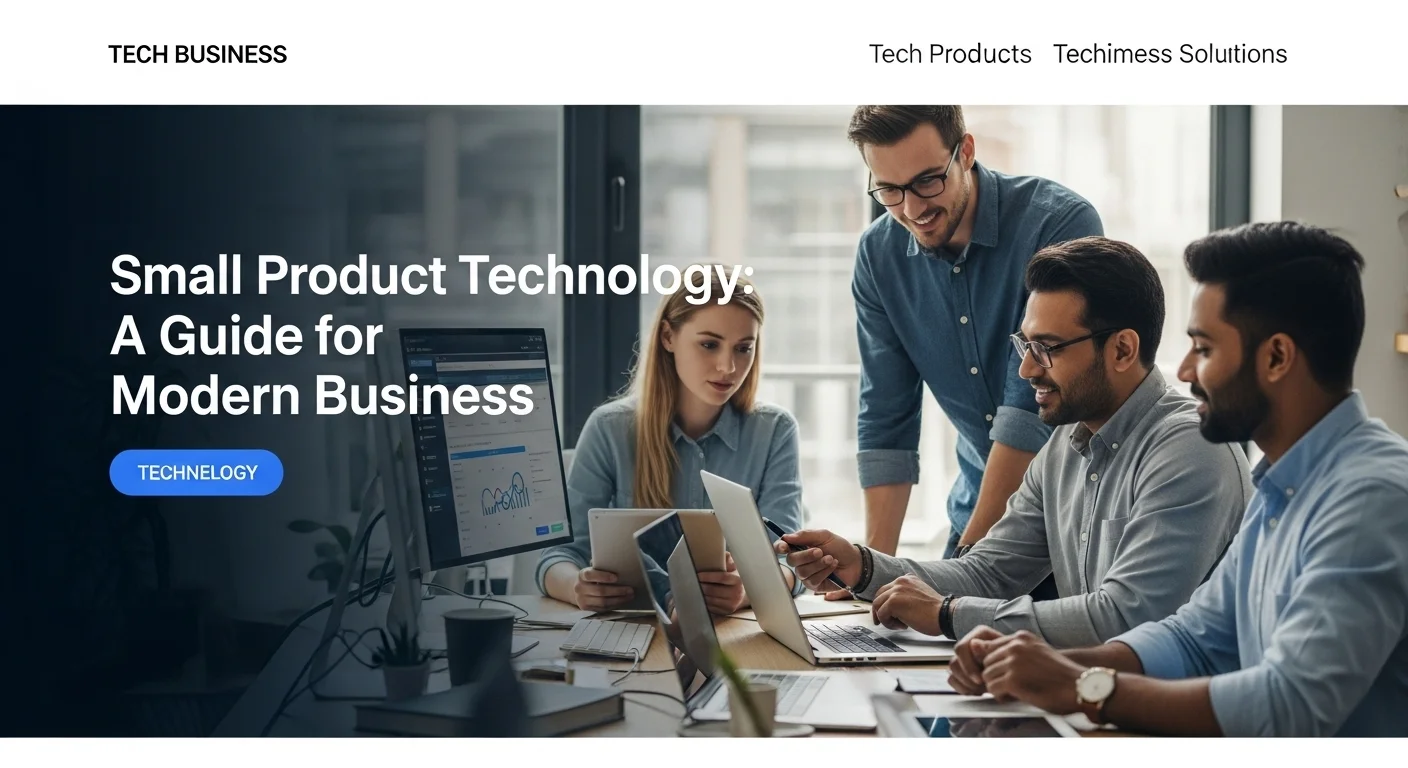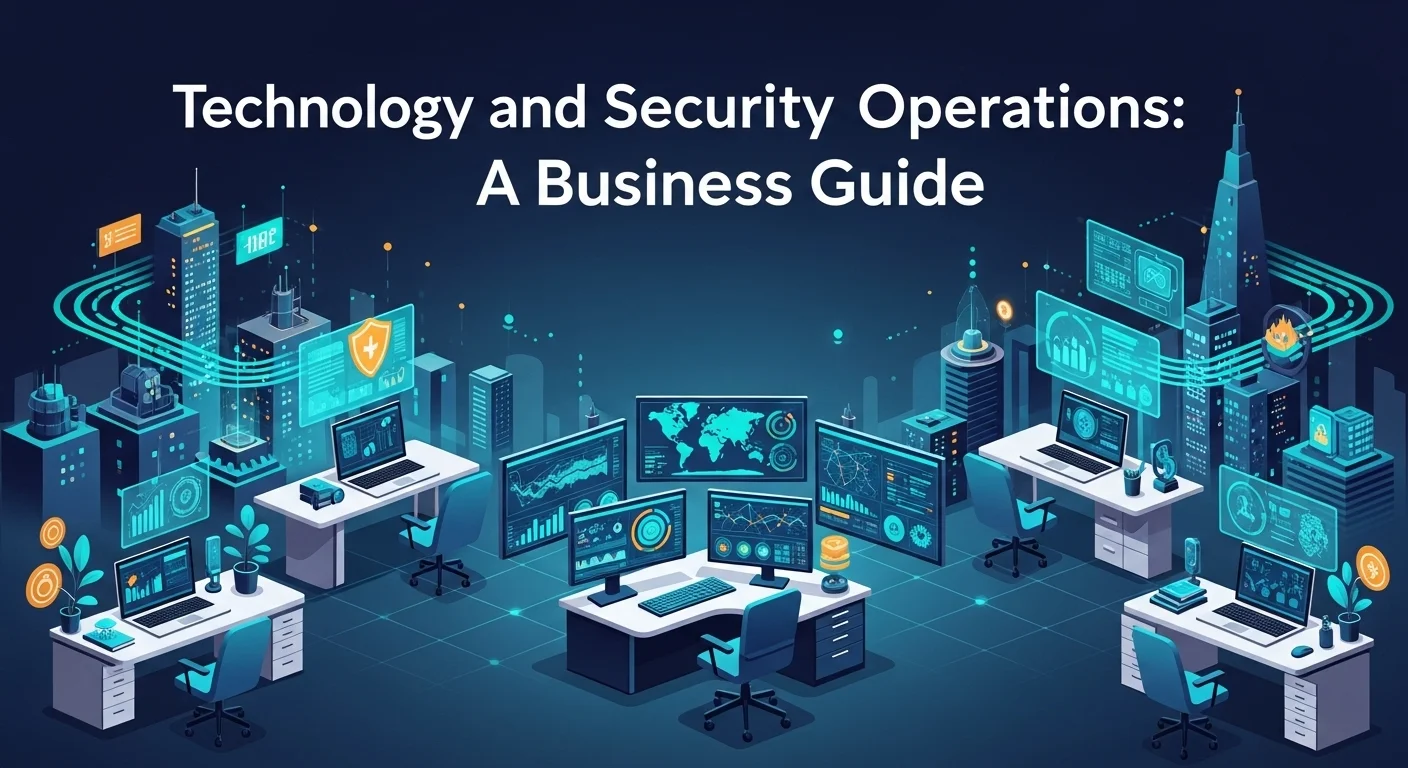The Quiet Revolution of Small Tech: Your Guide to Building a Winning Product

Executive Summary
In a world screaming about unicorns and massive platforms, I've noticed a quieter, more powerful revolution taking place: the rise of the 'Small Product.' These aren't just scaled-down versions of big software; they are hyper-focused tools that solve one problem, and solve it beautifully. This article is my deep dive into this exciting world. We'll explore what makes a small tech product—from a clever mobile app to a niche SaaS tool—so effective. I'll break down how powerful technologies like AI and cloud computing are no longer just for the big players but are the secret weapons for entrepreneurs and small businesses. If you're a founder, a maker, or just curious about the future of tech, this guide will show you how to turn a sharp idea into a successful, disruptive product.
Table of Contents
Table of Contents
What is a Small Product and Why Does It Matter in Tech?
I've spent years in the tech world, and it's easy to get mesmerized by the giants and their sprawling software suites. But the real magic I see today is happening on a much smaller scale. It's the rise of the 'Small Product.' So, what do I mean by that? It’s not about size or features. A Small Product is a lean, intensely focused solution built to solve a specific problem for a specific group of people, and to do it better than anyone else. Think of that one simple mobile app you can't live without, a micro-SaaS platform that perfectly fits your industry's weird workflow, or a smart gadget that automates one little task in your home. These stand in beautiful contrast to the monolithic apps that try to be a jack-of-all-trades and end up being a master of none, leaving users confused and frustrated.
The importance of this shift is huge. It’s about being agile, focusing on the user, and making innovation accessible to everyone. For startups and small businesses, this approach is a game-changer. I’ve seen countless companies burn through funding trying to build a massive, feature-packed product. It takes forever, costs a fortune, and the risk is sky-high. A small product, however, can be built by a tiny team—sometimes just one person—launched quickly as a Minimum Viable Product (MVP), and improved based on what real people actually do and say. This lean method is the heart of small product development; it cuts down risk and gives you the best shot at creating something people truly want.
The Tech Behind Small Product Success
The boom in small products is directly tied to incredible technologies that are now within everyone's reach. These are the pillars that you can build your innovative ideas on.
Cloud Computing: Services like AWS, Microsoft Azure, and Google Cloud have completely changed the game. They offer powerful, scalable infrastructure on a pay-as-you-go basis. Gone are the days of needing a massive upfront investment in servers. You can spin up a database, launch your app, and scale up instantly as more users come on board. This gives a small business the kind of reliability that used to be reserved for huge enterprises, all on a budget.
Artificial Intelligence (AI) and Machine Learning (ML): AI isn't science fiction anymore; it’s a practical tool for making your product smarter and more personal. I've seen it used to power recommendation engines, automate customer service with chatbots, and analyze user behavior to give founders incredible insights. Imagine a beauty app that uses AI to analyze your skin via your phone’s camera and suggests a personalized routine. Or a tool for a small food business that uses AI to predict daily demand, cutting down on waste. With powerful APIs from companies like OpenAI and Google, adding these smarts to your product is easier than ever.
Cybersecurity: In our digital world, trust is everything. Even the smallest product handling user data has to be secure. Thankfully, you don't have to be a security guru anymore. Cybersecurity-as-a-service and built-in security tools on cloud platforms let you implement strong protections like end-to-end encryption and automatic vulnerability scans. A security breach can kill a small product before it even gets started, so this is absolutely non-negotiable.
Internet of Things (IoT): IoT tech is what lets us create smart, connected physical products. A small product could be a sensor that helps urban gardeners keep their plants watered, a smart lock for your door, or a wearable that tracks a specific health metric. The cost of sensors and microcontrollers has plummeted, opening the door for a flood of hardware innovation from individual creators.
Real-World Business Applications and Benefits
The small product mindset isn't just for software. Its principles can spark brilliant ideas in any industry. The trick is to find a specific, overlooked need and use technology to create a laser-focused solution.
Let's take beauty products, for example. Instead of launching an entire makeup line, you could start with a single, innovative product. How about a 'smart' lipstick that uses AI to create custom shades based on your outfit? Or a subscription box for niche, cruelty-free products, all managed through a sleek, automated cloud platform. Here, technology doesn't just support the product; it elevates it and creates a unique reason for customers to choose you.
The same thinking applies to food ventures. You could launch a service delivering pre-portioned meal kits from local farms, managed through an app that handles everything from ordering to delivery. The 'small product' is the seamless digital experience wrapped around the physical one. Cloud inventory helps prevent food waste, and a good CRM tracks customer preferences to personalize offers—all with affordable, scalable tech.
The benefits of this approach are crystal clear:
- Faster to Market: Focusing on core features means you can develop and launch much faster, letting you start learning and earning sooner.
- Lower Costs: A smaller scope means you need less money and fewer people, making it possible for more entrepreneurs to take a shot.
- Stay Flexible: Small products are much easier to adapt. If the market shifts or a new opportunity pops up, a small team can pivot in days, not months.
- Build a Real Connection: By serving a niche audience, you can create a strong community. You can talk directly to your users, understand them deeply, and build something they genuinely love and advocate for.
- A Foundation for Growth: A successful small product can be the start of something big. You can scale it, add features, and launch new products based on what you've learned. Just look at Wordle—a perfect example of a tiny product that exploded and was acquired by a major company.
In the end, small product technology empowers innovation from the ground up. It’s about choosing focus over feature bloat and customer love over corporate complexity. By harnessing the power of the cloud, AI, and strong security, anyone can turn a creative idea into a successful business. This isn't just a trend; it's the future of building things in our fast-moving digital world.

A Practical Guide to Building Your Small Product
Coming up with a great idea is just the first step. Turning that idea into a real-world small product requires a smart strategy that blends technical know-how with business savvy. This guide is your roadmap. I’ll walk you through how to develop, launch, and grow a small product, using modern tech and proven techniques to build something that truly connects with people.
The Lifecycle of a Small Tech Product: From Idea to Iteration
Building a small product isn't a straight line; it's a loop of creating, learning, and refining. I’ve seen this cycle play out time and again. It breaks down into these key phases:
1. Ideation and Validation: This is where it all begins. Your goal is to find a real problem to solve. Go beyond just brainstorming with your team. Dig into market research. Use tools like Google Trends and social media listening to find what people are complaining about or searching for. Ask yourself: Who am I building this for? What's their biggest frustration? How are they trying to solve it now, and why will my solution be a game-changer? Before you even think about code, you have to validate your idea. A classic mistake is building something nobody wants. Set up a simple landing page that explains your product's value and includes a sign-up form to see if people are interested. Run a small, cheap ad campaign. Talk to potential customers. You're looking for a strong signal that you're onto something.
2. Prototyping and MVP (Minimum Viable Product) Development: Once you have a validated idea, it's time to make it tangible. Start with a low-fidelity prototype using a tool like Figma. This helps you map out the user experience and design without the commitment of development. Then, focus on the MVP. I've seen so many founders get stuck here, trying to build Rome in a day. The MVP isn't a buggy, incomplete product. It's the simplest version of your product that solves the core problem for your first users. For a small food business, the MVP might be a basic Shopify site offering a few items for delivery in one neighborhood. The core functions—ordering and paying—must be rock-solid. The fancy loyalty program can come later. This lean approach is crucial for managing your resources.
3. Launch and Marketing: A launch isn't a one-day firework show; it's a rolling process. Consider a 'soft launch' to a small group to find bugs and get early testimonials. Plan your main launch carefully. Figure out where your target audience hangs out online. Is it Product Hunt for a new tech tool? Instagram for a lifestyle product? LinkedIn for a B2B service? Use content marketing—blog posts, videos, social media—to build buzz around the problem you're solving. Collaborating with a few micro-influencers in your niche can be incredibly effective for getting honest, early reviews.
4. Feedback, Analytics, and Iteration: After the launch, the real journey begins. Your product is now in the wild. You absolutely need systems to collect and analyze user feedback. Use tools like Google Analytics or Mixpanel to see how people are actually using your product. Where do they get stuck? What features do they love? Set up easy ways for them to talk to you, like an in-app chat or a community forum. This data is gold. It tells you what to build next. The cycle of building, measuring what happens, and learning from it is the engine that will drive your product's growth. Each update should make your product more valuable and harder to leave.
The Toolbox: Tech Methods and Business Techniques
Success comes from pairing the right technology with smart business moves. Here’s what I recommend keeping in your toolbox:
- Agile and Scrum: Work in an agile way. Break down your development into short 'sprints.' This keeps you flexible, allows for quick changes, and ensures you're constantly delivering improvements.
- API-First Design: From the start, build your product around a solid API (Application Programming Interface). This makes it much easier to connect with other services and build different versions of your app (like for mobile and web) down the road.
- Choosing the Right Tech Stack: Don't just chase the latest trend. Pick your technology based on what your project needs. For many web apps, something like the MERN stack (MongoDB, Express.js, React, Node.js) or a serverless architecture offers great speed and scalability. For an AI product, Python is usually the way to go. Focus on tech with strong community support.
- DevOps and Automation: Set up automated systems for testing and deploying your code (CI/CD). This streamlines the whole process, reduces human error, and lets you release updates much faster.
Business Techniques:
- Niche Marketing: Don't try to sell to everybody. Figure out exactly who your ideal customer is and focus your marketing efforts where they spend their time. If you're selling products for artisans, platforms like Etsy and Pinterest are your best bet.
- Smart Pricing: Your pricing is a key part of your business. For digital products, you could offer a free basic version (freemium), tiered subscriptions, or pay-per-use. Make sure your price reflects the value you provide.
- Customer Relationship Management (CRM): Use a CRM from day one, even if it's a simple one. It helps you keep track of conversations, personalize your communication, and spot opportunities to make your customers happier.
- Build a Community: Create a space for your users to connect with each other and with you. A Slack channel or a private Facebook group can be a powerful marketing tool and an amazing source of feedback. Make your users feel like they're part of the journey.
Resources at Your Fingertips
Today's entrepreneurs have an incredible array of resources. Cloud platforms like AWS and Google Cloud have free tiers that are perfect for launching an MVP. No-code tools like Bubble and Webflow let people without a technical background build impressive web apps. Communities like Indie Hackers are fantastic for getting feedback and support from other builders. For the business side, tools like Stripe for payments, Mailchimp for email, and HubSpot for CRM provide powerful, affordable solutions. The key is to pick tools that work well together and can grow with you. This ecosystem has truly leveled the playing field, making it easier than ever to bring great ideas to life.

Pro Tips for a Thriving Small Product Experience
Getting your small product off the ground is one thing; making it a long-term success is another. It’s a marathon of constant improvement. As you move past the launch phase, your focus needs to shift to refinement, optimization, and sustainable growth. Here are some of my go-to strategies to level up your tech, sharpen your business approach, and build a product that doesn't just survive, but thrives.
Best Practices for Long-Term Success
Sticking to best practices is what separates the fleeting successes from the resilient businesses. These should be the guiding principles for your decisions.
1. Obsess Over User Experience (UX) and User Interface (UI): A small product has to be a joy to use. A clunky, confusing interface will drive people away, no matter how great your technology is. Let me be blunt: good design is not a luxury, it's a core feature. This means adopting a user-first mindset in everything you do. Run regular usability tests—even just watching a few friends use your product can reveal shocking insights. Polish every detail, from the first time a user signs up to the way you phrase an error message. A smooth experience is what builds loyalty and gets people talking.
2. Bake in Cybersecurity from Day One: In a world where data is currency, security is not optional. It’s the foundation of trust. You have to build security into your product from its very core. This means using secure coding practices to prevent common attacks, implementing strong multi-factor authentication (MFA), and encrypting all sensitive data, both when it's moving and when it's stored. Keep all your software and dependencies updated to patch vulnerabilities. If your product handles any kind of personal or payment information, proving your commitment to security is how you earn your customers' trust. A single breach can destroy your reputation overnight.
3. Design for Scale, Even When You're Small: Your product might start small, but you should always build it with growth in mind. This involves making smart tech choices today that won't handcuff you tomorrow. Using a microservices architecture, for instance, can make it easier to update and scale different parts of your app independently. Leveraging serverless computing lets you automatically handle traffic spikes without having to manage servers yourself. This kind of foresight ensures that as your user base grows, your product stays fast and reliable, which is critical for long-term survival.
Leverage Business Tools and Automation to Work Smarter
Small teams can't afford to waste time. To compete with the big guys, you need to be efficient. That's where tools and automation become your secret weapons.
A Deeper Look at Essential Tools:
- Customer Relationship Management (CRM): A tool like HubSpot or Zoho is so much more than a contact list. Use it to map out the entire customer journey. Set up automated email sequences to guide new users, segment your audience for targeted marketing, and figure out which channels are actually bringing you paying customers.
- Automation Platforms: Services like Zapier and Make are superpowers for small teams. They let you connect all your different apps and automate tasks without writing a single line of code. For example, you could set up a 'zap' that automatically adds a new paying customer from Stripe to your Mailchimp list and sends a welcome message in your team's Slack. This frees up hours of manual, mind-numbing work.
- Analytics and Business Intelligence (BI): Go deeper than just page views. Tools like Mixpanel or Amplitude let you track exactly what users are doing inside your product. Define your Key Performance Indicators (KPIs)—like user activation or churn rate—and build dashboards to monitor them. This gives you a real-time pulse on the health of your business and lets you make decisions based on data, not guesses.
Learning from Real-World Wins and Fails
Some of the best lessons come from studying the stories of others. The tech world is full of examples. Look at Carrd, a platform for building simple, one-page websites. It was built by one person to solve his own problem, and it grew by staying ruthlessly focused on that one thing. Or The Skimm, which started as a simple email newsletter for a very specific audience (millennial women) and grew into a huge media company. These stories show the power of finding a niche and executing flawlessly. On the flip side, learn from the products that failed. They often lost focus, got bloated with unnecessary features, or never figured out a way to make money. Analyze these stories to sharpen your own strategy.
Future-Proofing Your Small Product
Technology never stands still. To stay relevant, you have to keep one eye on the future.
Hyper-Personalization with AI: The next frontier is making every user's experience unique. Use AI to tailor your product to the individual. This could mean a personalized interface, custom recommendations, or proactive support. The more your product feels like it was made just for them, the more valuable it becomes.
Sustainability in Tech: As people become more conscious of our planet, 'green tech' is moving from a buzzword to a business imperative. Think about the environmental impact of your choices. Choose cloud providers committed to renewable energy. Write efficient code that doesn't waste resources. Building a sustainable product can be a core part of your brand and attract a loyal following.
Exploring Web3 and Decentralization: While it's still early days, technologies like blockchain offer new ways of doing business. They can enable true digital ownership and community-governed products. It's not right for every product, but understanding the potential of this shift can spark new, innovative ideas. Keeping up with transformative tech is key, and expert analysis can be a great guide. For example, Gartner often highlights technologies poised to reshape industries, offering a glimpse into what's next. Gartner: 5 technologies that will transform enterprises.
By weaving these strategies into your plan, you can build a small product that is robust, scalable, and genuinely loved by its users. The path requires a mix of technical skill, smart business planning, and a relentless focus on your customer. Embrace the power of modern tools, learn from the journeys of others, and always look ahead. That is the recipe for turning a great small idea into a lasting success.
Expert Reviews & Testimonials
Sarah Johnson, Business Owner ⭐⭐⭐⭐
As a small business owner, I found this article insightful. It explains the 'what' and 'why' of small products well. I would have loved to see a few more real-world case studies to help me brainstorm for my own shop. Still, a great starting point!
Mike Chen, IT Consultant ⭐⭐⭐⭐
This was a really helpful overview of small product tech. As an IT consultant, I appreciated the breakdown of the tech pillars. Some parts got a bit technical for a general audience, perhaps, but it clarified the concept for me and gave me some new ideas for my clients.
Emma Davis, Tech Specialist ⭐⭐⭐⭐⭐
Absolutely fantastic read! This is one of the most comprehensive and clearly written guides on small product development I've seen. As a tech specialist, I found the connections between strategy and technology spot-on. Every point was actionable. Highly recommended!



